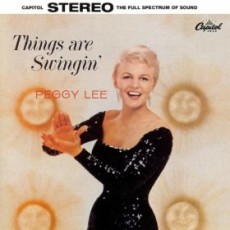
Daily Dose Of Jazz…
Peggy Lee was born Norma Deloris Egstrom on May 26, 1920 in Jamestown, North Dakota. The seventh of eight children of Norwegian and Swedish ancestry, her mother died when she was four. She began singing on a local radio station during her high school years, and then ventured to Fargo where Ken Kennedy of WDAY changed her name to Peggy Lee. At 17 she left home for Los Angeles.
Making her way to Chicago’s Buttery Room, Lee caught the attention of Lady Alice Duckworth who was so impressed brought her fiancé Benny Goodman the next night. That chance encounter landed her a gig with Goodman for two years, replacing Helen Forrest in 1941.
Peggy had her first #1 hit with “Somebody Else Is Taking My Place” in1942 followed by the million record seller “Why Don’t You Do Right” that made her famous by 1943. Her signature song became “Fever” to which she added some lyrics. In 1948 she joined Perry Como and Jo Stafford as one of the rotating host of NBC’s Chesterfield Supper Club. As a composer she collaborated with Laurindo Almeida, Duke Ellington, Quincy Jones, Johnny Mandel, Marian McPartland, Dave Grusin and Lalo Schifrin among others.
Lee played opposite Danny Thomas in the 1952 remake of the Jazz Singer, in 1955 played a despondent, alcoholic blues singer in Pete Kelly’s Blues that garnered her an Oscar nomination for Best Supporting Actress, and voiced several characters in Disney’s Lady and the Tramp for which she later had to sue Disney for video royalties.
From her humble beginnings as a vocalist on local radio she forged her own sophisticated persona, evolving into a multi-faceted artist and performer, receiving 12 Grammy nominations, three wins including a Lifetime Achievement Award and induction into the Songwriters Hall of Fame among other awards and accolades. Peggy Lee, whose career as a jazz and pop singer, songwriter, composer and actress spanned nearly seven decades passed away due to complications from diabetes and a heart attack on January 21, 2002.
More Posts: vocal
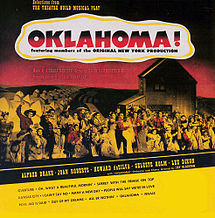
From Broadway To 52nd Street
The curtain rose on Oklahoma on the stage at the St. James Theatre on March 3, 1943. The cast consisted of Alfred Drake, Joan Roberts, Celeste Holm and Lee Dixon performing music and lyrics by Richard Rodgers and Oscar Hammerstein. Running 2,212 performances, the musical would go on to receive rave reviews as a film thirteen years later and str such greats as Shirley Jones, Gordon McRae, Rod Steiger and Eddie Albert. From the play came two songs that became jazz standards – People Will Say We’re In Love and The Surrey With The Fringe On Top.
The Story: The musical is about Laurie, a country girl, who is courted by a cowboy, Curly, and is pursued by the villain Jud, who also sees her as a love interest.
Broadway History: As change came to the Broadway play in the early 1940s, jazz musicians also sought change by looking for new directions to explore. A new style of jazz was born, called bebop. It had fast tempos, intricate melodies and complex harmonies. Bebop was considered jazz for intellectuals. The demise of the huge big bands was imminent to be replaced by smaller groups that did not play for dancing audiences but for listening audiences.
Sponsored By
www.whatissuitetabu.com
More Posts: broadway
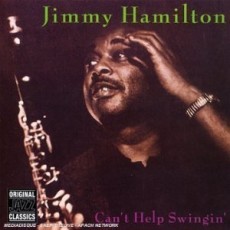
Daily Dose Of Jazz…
Jimmy Hamilton was born on May 25, 1917 in Dillon, South Carolina but grew up in Philadelphia. He learned to play piano and brass instruments and by the thirties he was playing the latter in local bands. He switched to clarinet and saxophone and by 1939 was playing with Lucky Millinder, Jimmy Mundy and Bill Doggett, then going to work for Teddy Wilson in 1940.
After a two-year stay with Wilson he played with Eddie Heywood and Yank Porter before replacing Barney Bigard in Duke Ellington’s orchestra in 1943. Over the next twenty-five years with Ellington his sound on saxophone had an R&B style while his clarinet was more precise, correct and fluent and it was during this time that he wrote some of his own material.
Leaving the Ellington orchestra, Hamilton played and arranged on a freelance basis, before spending the 1970s and 1980s in the Virgin Islands teaching music, occasionally returning to the U.S. for performances with John Carter’s Clarinet Summit. He retired from teaching but continued to perform with his own groups from 1989 to 1990.
The clarinetist, saxophonist, arranger, composer and music educator Jimmy Hamilton died in St. Croix, Virgin Islands at the age of seventy-seven on September 20, 1994.
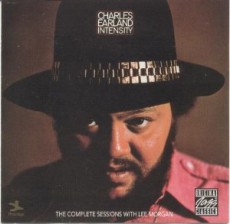
Daily Dose Of Jazz…
Charles Earland was born in Philadelphia, Pennsylvania on May 24, 1941 and learned to play the saxophone in high school. By age 17 he was playing tenor with Jimmy McGriff and in 1960 started his first group. He didn’t start playing the organ until after a stint with Pat Martino, then joined Lou Donaldson’s band until 1969.
Earland led a successful group in 1970 that included Grover Washington, Jr. and he eventually started playing the soprano saxophone and synthesizer but it was his simmering organ grooves the earned him the nickname “The Mighty Burner”.
In 1978 Earland hit the disco/club scene with “Let the Music Play” written by Randy Muller from Brass Construction. The record hit the U.S. charts for 5 weeks and reached number 46 in the U.K. Singles chart. From 1988 he traveled extensively performing worldwide with one of his many career highlights being to play the Berlin Jazz Festival in 1994.
He continued to perform throughout the U.S. and abroad until his death from heart failure in Kansas City, Missouri at the age of fifty-eight on December 11, 1999. Charles Earland, The Mighty Burner, was a composer, organist, and saxophonist in the soul jazz idiom.
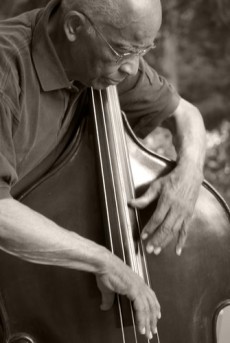
Daily Dose Of Jazz…
Bassist Julian Euell was born on May 23, 1929 in New York City. He first began playing bass in 1944, served in the Army from 1945-47 and after his discharge began playing with Sonny Rollins, Jackie McLean and Art Taylor that same year. He quit music in ’49 for steady work in the post office eventually studying under Charles Mingus in ’52 and attending Julliard fro 1953 to 1956. He also took classes at NYU, earned a bachelor’s degree from Columbia University and subsequently taught there.
His musical associations during the fifties were with Elmo Hope, Benny Harris, Charlie Rouse, Joe Roland, Freddie Redd, Gigi Gryce and Phineas Newborn. Leaving music again late in the decade he found employment in New Jersey as a social worker. Though less active at this time he continued to perform with Mal Waldron, Randy Weston, Abbey Lincoln, Charles Mingus and Kenny Dorham.
In the 1960s Euell worked in Harlem directing an arts program and then returned to school, receiving a Ph.D. from George Washington University in 1973. He was Assistant Secretary for Public Service at the Smithsonian from 1970-1982, and was partly responsible for the institution’s increasing interest in jazz history. From 1983 to 1988 he directed the Oakland Museum History-Arts-Science and from 1991-95 was director of the Louis Armstrong House. He returned to semi-regular performing in the 1980s and 1990s.
More Posts: bass



